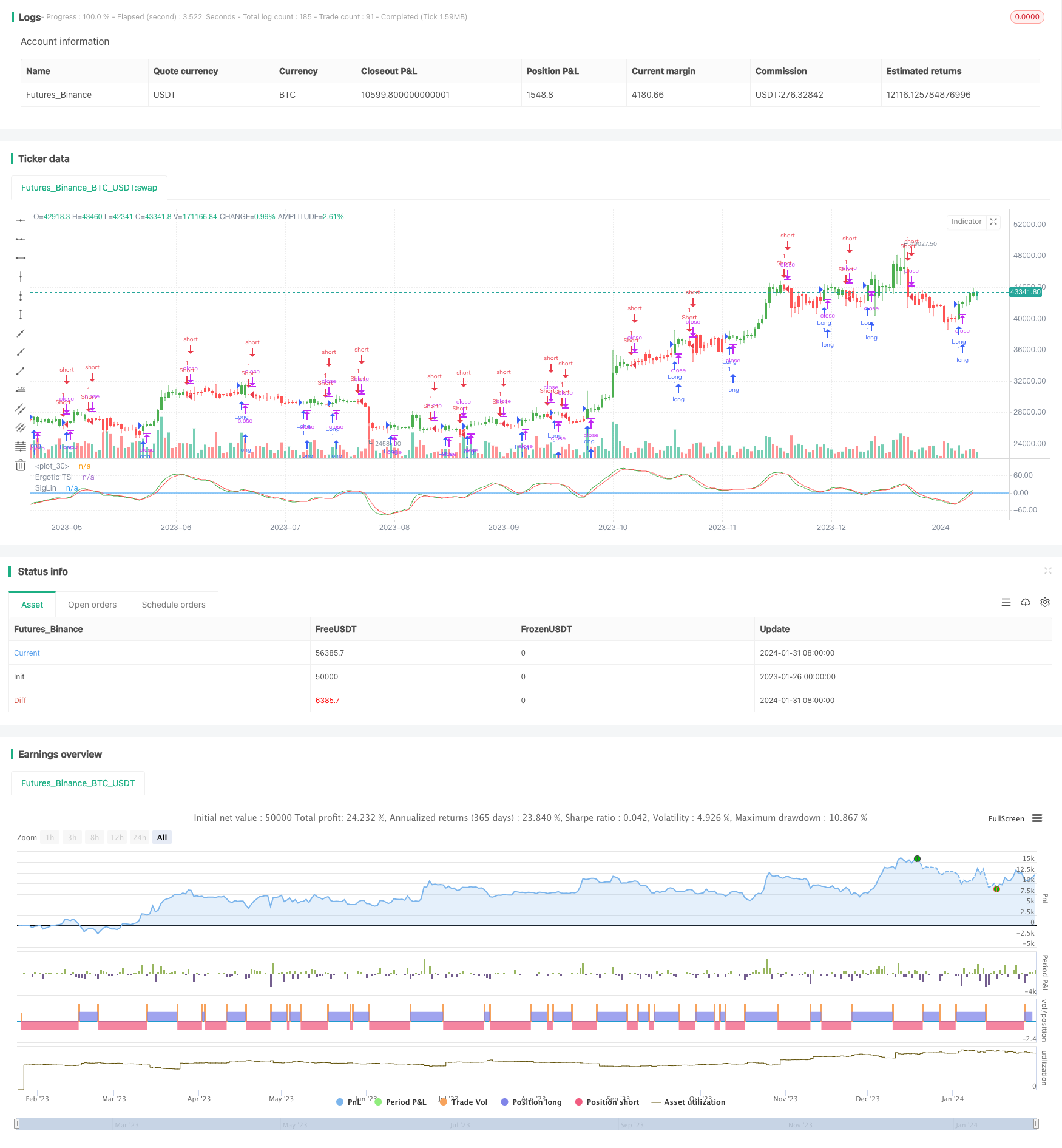Estratégia de negociação de convergência da direção do ímpeto ergótico
Autora:ChaoZhang, Data: 2024-02-02 10:51:11Tags:

Resumo
O nome desta estratégia é a Estratégia de Negociação de Convergência de Direção de Momento Ergótico. É uma estratégia de negociação quantitativa projetada com base no indicador técnico descrito no livro de William Blau
Estratégia lógica
O principal indicador desta estratégia é a ETI "Ergotica", cuja fórmula de cálculo é a seguinte:
Val1 = 100 * EMA(EMA(EMA(price change, r), s), u)
Val2 = EMA(EMA(EMA(absolute value of price change, r), s), u))
Ergotic TSI = If Val2 != 0, Val1/Val2, else 0
onde r, s, u são parâmetros de suavização. Este indicador reflete a relação entre a mudança de preço e o valor absoluto da mudança de preço, que pertence ao indicador do oscilador de momento. Em seguida, calcula-se a média móvel EMA da TSI Ergotic como a linha de sinal. Vá longo quando a TSI cruza a linha de sinal e vá curto quando cruza abaixo.
Análise das vantagens
As principais vantagens desta estratégia são:
- Forte capacidade para captar as tendências de variação dos preços
- Boa filtragem das flutuações de preços
- Características de divergência relativamente boas
- Configurações de parâmetros flexíveis para ajustar a suavização
Análise de riscos
Esta estratégia apresenta também alguns riscos:
- Podem ocorrer sinais errados nos pontos de inversão da tendência
- Configurações inadequadas dos parâmetros podem perder oportunidades de negociação ou aumentar os falsos sinais
- Os parâmetros devem ser adequadamente ajustados para se adequarem aos diferentes produtos e ambientes comerciais Os riscos podem ser controlados através da otimização de parâmetros, da combinação de outros indicadores para confirmação e da definição de stop loss.
Orientações de otimização
Esta estratégia pode ser otimizada nos seguintes aspectos:
- Teste diferentes entradas de preço, tais como preço aberto, fechado, médio, etc.
- Ajustar os valores dos parâmetros r, s, u para encontrar combinações ótimas de parâmetros
- Adicionar outros indicadores ou filtros para confirmar mais sinais
- Estabelecer pontos de stop loss e mecanismos de saída
Conclusão
Esta estratégia integra considerações de mudança de momento, julgamento da tendência e características de divergência. Pode capturar efetivamente oportunidades de tendência. Com otimização de parâmetros, filtragem de sinal e métodos de controle de risco, um bom desempenho da estratégia pode ser alcançado.
/*backtest
start: 2023-01-26 00:00:00
end: 2024-02-01 00:00:00
period: 1d
basePeriod: 1h
exchanges: [{"eid":"Futures_Binance","currency":"BTC_USDT"}]
*/
//@version = 2
////////////////////////////////////////////////////////////
// Copyright by HPotter v1.0 13/12/2016
// r - Length of first EMA smoothing of 1 day momentum 4
// s - Length of second EMA smoothing of 1 day smoothing 8
// u- Length of third EMA smoothing of 1 day momentum 6
// Length of EMA signal line 3
// Source of Ergotic TSI Close
//
// This is one of the techniques described by William Blau in his book "Momentum,
// Direction and Divergence" (1995). If you like to learn more, we advise you to
// read this book. His book focuses on three key aspects of trading: momentum,
// direction and divergence. Blau, who was an electrical engineer before becoming
// a trader, thoroughly examines the relationship between price and momentum in
// step-by-step examples. From this grounding, he then looks at the deficiencies
// in other oscillators and introduces some innovative techniques, including a
// fresh twist on Stochastics. On directional issues, he analyzes the intricacies
// of ADX and offers a unique approach to help define trending and non-trending periods.
//
// You can use in the xPrice any series: Open, High, Low, Close, HL2, HLC3, OHLC4 and ect...
// You can change long to short in the Input Settings
// Please, use it only for learning or paper trading. Do not for real trading.
////////////////////////////////////////////////////////////
strategy(title="Ergotic TSI Strategy Backtest")
r = input(4, minval=1)
s = input(8, minval=1)
u = input(6, minval=1)
SmthLen = input(3, minval=1)
reverse = input(false, title="Trade reverse")
hline(0, color=blue, linestyle=line)
xPrice = close
xPrice1 = xPrice - xPrice[1]
xPrice2 = abs(xPrice - xPrice[1])
xSMA_R = ema(ema(ema(xPrice1,r), s),u)
xSMA_aR = ema(ema(ema(xPrice2, r), s),u)
Val1 = 100 * xSMA_R
Val2 = xSMA_aR
xTSI = iff (Val2 != 0, Val1 / Val2, 0)
xEMA_TSI = ema(xTSI, SmthLen)
pos = iff(xTSI > xEMA_TSI, 1,
iff(xTSI < xEMA_TSI, -1, nz(pos[1], 0)))
possig = iff(reverse and pos == 1, -1,
iff(reverse and pos == -1, 1, pos))
if (possig == 1)
strategy.entry("Long", strategy.long)
if (possig == -1)
strategy.entry("Short", strategy.short)
barcolor(possig == -1 ? red: possig == 1 ? green : blue )
plot(xTSI, color=green, title="Ergotic TSI")
plot(xEMA_TSI, color=red, title="SigLin")
- Estratégia dinâmica de cruzamento entre SMMA e SMA
- Estratégia baseada em bandas de Bollinger, RSI e média móvel
- Estratégia de negociação de tendências baseada no indicador MACD
- Estratégia de média estocástica e móvel com filtros duplos
- Estratégia de tendência baseada no RSI
- Estratégia de ruptura da média móvel de ponto único
- Estratégia de cruzamento da média móvel
- Estratégia SuperTrend
- Parabólica período e Bollinger Band combinado Moving Stop Loss estratégia
- Estratégia de negociação baseada no preço médio móvel
- Estratégia de negociação de média móvel e estocástica
- Uma otimização da tendência de média móvel dupla seguindo uma estratégia baseada na combinação de indicadores
- A estratégia de negociação quantitativa eficiente combinando
- Estratégia combinada de cruzamento de média móvel dupla e indicador Williams
- Estratégia da Linha Prateada de Impulso
- Estratégia contrária à volatilidade do RWI
- Estratégia de reversão de perdas de rastreamento de tendências SAR parabólica
- Estratégia de cruzamento do indicador de impulso
- Estratégia de interrupção de oscilação eficiente com duplo stop profit e stop loss
- Estratégia de ruptura de canal duplo